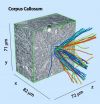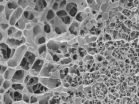(Press-News.org) A research team from the University of Bristol's Centre for Quantum Photonics (CQP) have brought the reality of a quantum computer one step closer by experimentally demonstrating a technique for significantly reducing the physical resources required for quantum factoring.
The team have shown how it is possible to recycle the particles inside a quantum computer, so that quantum factoring can be achieved with only one third of the particles originally required. The research is published in the latest issue of Nature Photonics.
Using photons as the particles, the Bristol team constructed a quantum optical circuit that recycled one of the photons to set a new record for factoring 21 with a quantum algorithm - all previous demonstrations have factored 15.
Dr Anthony Laing, who led the project, said: "Quantum computers promise to harness the counterintuitive laws of quantum mechanics to perform calculations that are forever out of reach of conventional classical computers. Realising such a device is one of the great technological challenges of the century."
While scientists and mathematicians are still trying to understand the full range of capabilities of quantum computers, the current driving application is the hard problem of factoring large numbers. The best classical computers can run for the lifetime of the universe, searching for the factors of a large number, yet still be unsuccessful.
In fact, Internet cryptographic protocols are based on this exponential overhead in computational time: if a third party wants to spy on your emails, they will need to solve a hard factoring problem first. A quantum computer, on the other hand, is capable of efficiently factoring large numbers, but the physical resources required mean that constructing such a device is highly challenging.
CQP PhD student Enrique Martín-López, who performed the experiment, said: "While it will clearly be some time before emails can be hacked with a quantum computer, this proof of principle experiment paves the way for larger implementations of quantum algorithms by using particle recycling."
###Paper: Experimental realization of Shor's quantum factoring algorithm using qubit recycling, Enrique Martín-López, Anthony Laing, Thomas Lawson, Roberto Alvarez, Xiao-Qi Zhou and Jeremy L. O'Brien, Nature Photonics, 21 October 2012.
Quantum computing with recycled particles
2012-10-23
ELSE PRESS RELEASES FROM THIS DATE:
A circuit diagram of the mouse brain
2012-10-23
This press release is available in German.
What happens in the brain when we see, hear, think and remember? To be able to answer questions like this, neuroscientists need information about how the millions of neurons in the brain are connected to each other. Scientists at the Max Planck Institute for Medical Research in Heidelberg have taken a crucial step towards obtaining a complete circuit diagram of the brain of the mouse, a key model organism for the neurosciences. The research group working with Winfried Denk has developed a method for preparing the whole mouse ...
Lung mucus gel scaffold prevents nanoparticles from getting through
2012-10-23
Mucus coats our airways' internal surfaces. The viscous gel humidifies the lungs and prevents viruses and other small particles like diesel soot from entering the body unchecked. Previously unclear was the extent to which such nanoparticles are able to move through the lungs' mucus. Here, the research evidence was contradictory. Scientists could not explain why, in inhaled medication development, drug nanoparticles often simply got stuck in the mucus never making it to their target destination inside the lung cells.
Now, as part of a German Research Foundation (DFG)-funded ...
The complex association between moderate alcohol consumption and breast cancer
2012-10-23
An excellent review article from two scientists at the National Institute on Alcohol Abuse and Alcoholism in the USA to be published in Alcohol Clin Exp Res 2012, describes the epidemiologic and basic scientific evidence linking alcohol consumption to the risk of breast cancer.
The authors point out deficiencies in the epidemiologic data, especially that the pattern of drinking (regular moderate versus binge drinking) has generally not been taken into consideration, important given that binge drinking is associated with much higher blood alcohol concentrations and acetaldehyde ...
TIM and TAM: 2 paths used by the Dengue virus to penetrate cells
2012-10-23
By demonstrating that it is possible to inhibit the viral infection in vitro by blocking the bonding between the virus and these receptors, the researchers have opened the way to a new antiviral strategy. These works were published on line in the review "Cell Host & Microbe" of October 18, 2012.
The Dengue virus circulates in four different forms (four serotypes). It is transmitted to humans by mosquitoes. It is a major public health problem. Two billion people throughout the world are exposed to the risk of infection and 50 million cases of Dengue fever are recorded by ...
19 species of ferns named for Lady Gaga
2012-10-23
DURHAM, N.C. -- Pop music megastar Lady Gaga is being honored with the name of a new genus of ferns found in Central and South America, Mexico, Arizona and Texas. A genus is a group of closely related species; in this case, 19 species of ferns will carry the name Gaga.
At one stage of its life, the new genus Gaga has somewhat fluid definitions of gender and bears a striking resemblance to one of Gaga's famous costumes. Members of the new genus also bear a distinct DNA sequence spelling GAGA.
Two of the species in the Gaga genus are new to science: Gaga germanotta from ...
Moffitt researchers study how patterns, timing of sunlight exposure contribute to skin cancers
2012-10-23
Researchers at Moffitt Cancer Center, the University of South Florida and the International Agency for Research on Cancer in France have studied the patterns and timing of sunlight exposure and how each is related to two nonmelanoma skin cancers – basal cell carcinoma and squamous cell carcinoma.
This study, published in the open-access journal BioMed Central, is the first case-control study to simultaneously evaluate identical patterns and timing of sunlight exposure as they are related to basal cell and squamous cell carcinomas in the same U.S. population with high ...
Vanderbilt researchers find that diabetes drug could be effective in treating addiction
2012-10-23
Vanderbilt researchers are reporting today that a drug currently used to treat type 2 diabetes could be just as effective in treating addiction to drugs, including cocaine.
The findings, published online today as a Letter To The Editor in the journal Molecular Psychiatry, could have far-reaching implications for patients worldwide who suffer from addiction.
"What we have demonstrated is that a brain mechanism already known to be therapeutic for the treatment of diabetes also appears to be implicated in at least certain types of drug addiction," said Gregg Stanwood, ...
New American Chemical Society videos celebrate 25 years of National Chemistry Week
2012-10-23
WASHINGTON, Oct. 23, 2012 — The American Chemical Society (ACS) today released two new videos celebrating the 25th Anniversary of National Chemistry Week (NCW). The videos, from the world's largest scientific society, coincide with the start of this year's NCW, being observed in hundreds of communities around the country. Both videos are available now at www.BytesizeScience.com.
One video is a new episode of ACS' award-winning Bytesize Science series. It highlights research behind this year's NCW theme — nanotechnology. The second video is a retrospective on the history ...
Engaging parents leads to better treatments for children with adhd
2012-10-23
Philadelphia, October 23 Pediatricians and researchers at The Children's Hospital of Philadelphia's(CHOP) have developed a first-of-its kind tool to help parents and health care providers better treat ADHD (attention deficit-hyperactivity disorder). The new, three-part survey helps steer families and doctors toward "shared decision-making", an approach proven to improve healthcare results in adults, but not widely used in pediatric settings. The results of the CHOP study are published in the journal Academic Pediatrics.
"Shared decision-making in health care means ...
Lubricants from vegetable oil
2012-10-23
Epoxides are highly reactive organic compounds comprised of a triple ring with two carbon atoms and one oxygen atom. Among other things, the chemicals industry uses them for the production of lubricants for vehicles and engines, as well as surfactants and emulsifiers for detergents and cleansers. Until now, epoxides have been based primarily on source materials procured from petroleum. Researchers at the Fraunhofer Institute for Interfacial Engineering and Biotechnology IGB have engineered a chemical-enzymatic process that now enables vegetable oil-based production, at ...


